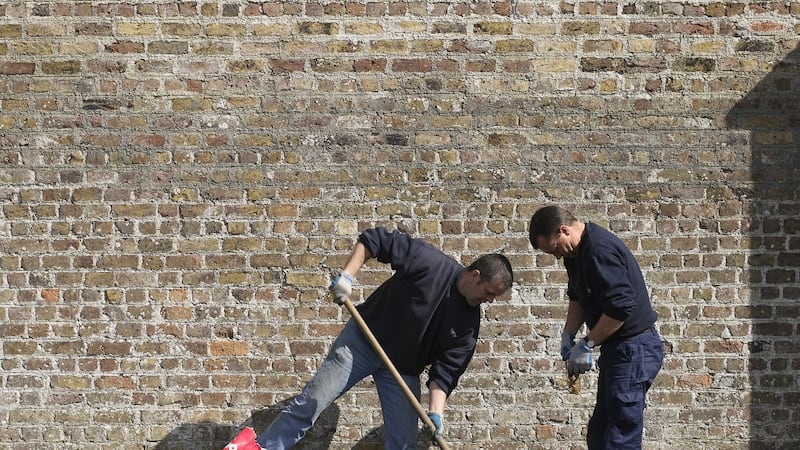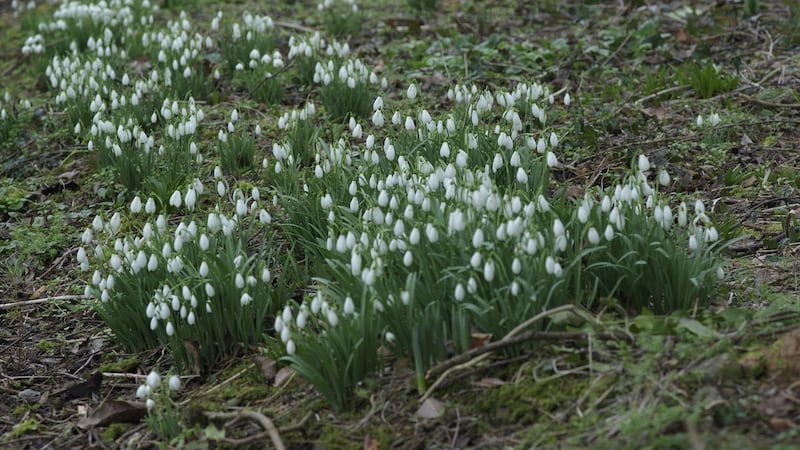Like shiny-haired, doe-eyed contestants in a reality TV show, it’s the prettiest plants in fullest leaf and bonniest bloom – those exhibiting what the marketing industry calls “pot appeal” – that inevitably catch our magpie eye in garden centres and nurseries. All the more so when they come in colourful plastic containers in pretty pastel shades cunningly designed to entice us.
Bare-root plants, on the other hand, are a much harder sell; deep in winter hibernation, typically leafless (bar evergreen species), their naked root systems stripped clean of any soil or compost, they require a leap of faith.
Yet compared with their container-grown equivalents, they are far and away the more planet-friendly, economical option. There’s no plastic waste, for example, and no peat-based compost. They’re also much easier, lighter and more space-efficient to package and transport, making it entirely feasible to order them online in large quantities (see below for a list of recommended Irish suppliers).
Less troublesome to plant (their planting holes require less extensive excavation), they’re very quick to establish. They are also far cheaper, typically costing as little as a half to a third of their container-grown equivalents; for anyone planting a new or large garden, the potential savings involved are considerable.

Convinced? Here’s a handy little guide to their use.
When to plant? Unlike container-grown plants that can technically be planted at any time of the year, bare-root plants must be planted during what's known as the bare-root season, while the plants are in winter hibernation and soil moisture levels are good. This planting window typically runs from November to the end of March, but in cold years it may start a little earlier and/or end a little later while in mild years, the opposite is true. In colder or more exposed gardens or those with heavy soil prone to winter waterlogging, late winter/early spring planting (February-March) is best.
How to plant them? Pre-soak the roots in a bucket of clean water for about 30 minutes before swiftly planting into a pre-dug, wide, shallow hole that's large enough to easily accommodate the root system when spread out (intriguingly, research shows that a square hole is best for encouraging healthy root establishment).
If you’re planting hedging, dig a shallow trench instead of a hole. Alternatively, if you’re planting what are known as “whips” (very young trees with no lateral branches), these can be planted into simple slits in the ground. To make these, plunge a sharp spade vertically into the soil to the depth of the blade, rock it back and forth, then slot the roots into the slit to the correct planting depth, back-fill and firm in.
Most species do best in a fertile, weed-free, damp but free-draining soil. If yours is very poor/unusually heavy or very light, mix in just a little well-rotted manure or homemade garden compost but don’t overdo it as this can create a sump, encouraging rainwater to collect and causing the plant’s roots to rot.
In gardens prone to winter waterlogging, plant into gently raised mounds (no more that 25-30cm high and 1m wide). If you’re using a tree stake (these often aren’t necessary), position this in the hole before planting, making sure to place it to the windward side of the hole and 8-10cm away from the trunk of the tree itself (this avoids it chafing against the stem/trunk).
Always bear in mind that planting too deeply is by far the most common cause of death of young trees and shrubs; to avoid this, make sure to plant so that the original soil line on the trunk/stem matches the new finished soil level, gently spreading out the roots rather than bunching them into the hole. The root collar (the part of the tree/shrub where the roots meet the trunk) should be level with the finished surface, never beneath it. Back fill using the original excavated topsoil, water well, then use your foot to gently firm in the plant, before checking again that the finished soil level is correct.
What about aftercare? It's important to keep the soil around the plant weed-free to encourage good root establishment and healthy growth. Some gardeners like to use a shallow layer of mulch to do this; just make sure it's not deep (another common mistake) and that it doesn't come into direct contact with the trunk/root collar to avoid problems with disease. In gardens where deer, rabbits or hares are a problem, you may also need to use a tree guard or chicken wire to protect against damage. If planting is followed by a spring drought, then additional watering will be temporarily required.
What if you can’t plant them straight away? The rule of thumb is to plant bare-root plants as soon as possible after purchase or delivery to avoid the risk of their vulnerable root systems drying out, being damaged or even killed by a harsh frost. But if the soil is waterlogged or frozen hard, then wait for conditions to improve. In the meantime, keep the plants upright in a cool, frost-free shed and make sure to protect/cover their roots by either storing them in their original packaging (spritz the roots with water occasionally to keep them damp) or placing them in a bag of damp compost.
Alternatively, when soil conditions are suitable but you need to delay planting to a more opportune time, then “heel in” the plants by burying their roots in a temporary planting hole in the garden.
Where to buy them? Most good Irish garden centres and nurseries stock a range of bare-root plants at this time of year while some also offer a countrywide mail-order service. Some (not all) also do everything that they can to minimise waste by using recycled or sustainable packaging.
Among the best is Cork-based Future Forests (futureforests.ie) which offers a very extensive collection including many different kinds of bare-root tree and bush fruit, nut trees, hedging (their wildlife-friendly hedging and permaculture hedging are both best sellers), asparagus, Japanese cherry trees and a range of ornamental rowan (Sorbus) as well as more unusual specimen trees. Clare-based Irish Seed Savers is the place to go to for a very wide range of bare-root apple trees including many historic Irish cultivars (irishseedsavers.ie); Cork-based MacNamara Roses for barer-root roses and fruit varieties (087-1415739) and Clare-based CELT nursery for certified-native bare-root trees and shrubs (celtnet.org) while the not-for-profit Mayo-based Fruit & Nut (fruitandnut.ie) nursery offers an extensive selection of productive trees and shrubs.
Other Irish nurseries that carry a generous range of bare-root plants include Wicklow-based Van der Wel (vanderwel.ie); Cork-based Nangle & Niesen (nangleandniesen.ie), Wexford-based English's Fruit Nursery (englishsfruitnursery.ie and for perennials, Antrim-based Bali Hai Nursery (mailorderplants4me.com).
This week in the garden
Keep a careful watch out for emerging bulbs and early-flowering herbaceous perennials as they push their way through the soil at this time of year; it can be all too easy to accidentally behead them when weeding or hoeing. Similarly keep a careful eye out for emerging spring-flowering bulbs that have naturalised in grass when mowing or walking on the lawn.
Pot up lily bulbs into containers filled with a John Innes compost and then grow on under cover of an unheated glasshouse, polytunnel or bright porch for early flowering plants this summer. Make sure to water the pots only very sparingly until you see the first signs of growth pushing through the surface of the compost as their fleshy bulbs are especially prone to rotting when left sitting in damp compost. Recommended stockiest include mrmiddleton.ie
Check this out
Newly updated and revamped, the garden.ie website is home to Ireland's biggest online garden club and is a mine of useful horticultural information and know-how specifically tailored for Irish growing conditions, much of it written by the well-known broadcaster, garden writer and Irish Garden magazine editor, Gerry Daly. You can also use its handy search function to find a list of recommended local suppliers, garden clubs and gardens open to the public in your locality.

Dates for your diary
Throughout February, it's "Snowdrop Month in Carlow" with guided tours of some of the country's finest snowdrop collections open to the public including Altamont, Shankill Castle, Huntington Castle Burtown, see carlowgardentrail.com for details. Other well-known Irish snowdrop gardens also open to the public include Bellefield Garden, Shinrone, Birr, Co Offaly (11am-4.30pm, until Sunday, February 16th, angelajupe.ie) and Primrose Hill, Lucan, Co Dublin (throughout February, 2-6pm).
Saturday, February 8th from 2pm, Woodville Walled Garden, Kilchreest, Co Galway, Annual Snowdrop Day with the horticulturist and galanthophile Paul Smyth as guest speaker and a guided tour of the gardens by its head gardener Marie Forde, admission €15, pre-booking essential, call 087-9069191 or email woodvillegardens@gmail.com; Thursday, February 13th (8pm), Artane Beaumont Family Recreation Centre, Kilmore Road, Artane, Dublin 9, "Creating a Garden" a talk by Dominica McKevitt, head gardener at Ardgillan Castle on behalf of Dublin Five Horticultural Society, admission €5, call 087-2423020 for details: Saturday, February 29th,"Seeds of Change: Planting Design for the 21st Century", GLDA 2020 Seminar, Saturday, Crowne Plaza Hotel, Santry, Dublin 9 with guest speakers Nigel Dunnett, Cassian Schmidt, Sandro Cafolla and Sarah Price. From €95 for GLDA members, €120 non-members, with a non-members early-bird offer of €110, see glda.ie for details.













